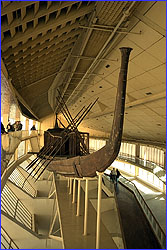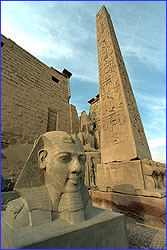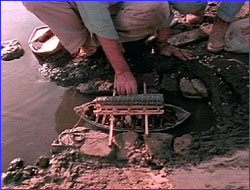
|
 |
 |
by Peter Tyson Everybody likes a second chance, and our NOVA obelisk-raising team is no exception. Though they learned a lot in the process, their first attempt failed, and they're positively itching to have another go of it. Join them in their second attempt by following the itinerary below and reading the dispatches as they come in. (Please note that schedules change, and this itinerary is our best guess as to how the project will unfold.) Week 1 (March 4-12): Cairo/Giza and Luxor During the first week of this expedition to Egypt, the team will visit Cairo (including Giza) and then Luxor. In artifacts, hieroglyphs, and other remains from pharaonic times, they will investigate obelisks and references to how they were made and transported. Their first stop is Giza, where they will examine the Solar Barque, the world's oldest planked boat, for clues to ancient boat-building. They will talk with Zahi Hawass, Director of the Pyramids, and possibly Hag Achmed, who reconstructed the disassembled vessel after it was discovered in 1954. Along the Nile, the team will then test a model of an obelisk-carrying barge depicted on the walls of Hatshepsut's mortuary temple in Luxor.
Traveling south to Luxor, site of ancient Thebes, the NOVA crew will first visit various tombs in the Valley of the Kings to get a sense of the New Kingdom pharaohs who were responsible for erecting these towers of stone. Just over a hill from the Valley of the Kings lies Hatshepsut's mortuary temple at Deir el Bahri, where the team will analyze the eroded wall relief showing two obelisks being transported by barge down the Nile.
Week 2 (March 13-19): Aswan With preliminary investigations over, the team will travel on the 13th to Aswan, where the attempt to raise a 35-ton obelisk will take place. In the coming week, the crew will test methods for quarrying, dragging, and loading and shipping obelisks on boats.
Down on the Nile, the crew will visit with a modern Egyptian boat builder and then float models of ancient boats, including a catamaran and a wide-bodied barge. Both were designed by Owain Roberts, who will demonstrate how these vessels could have transported obelisks. The team will then drag a nine-foot obelisk down a ramp to a specially designed dock, load it onto a barge, and then off-load it—all to show how the pharaohs' engineers might have done it. Continue: Week 3 Explore Ancient Egypt | Raising the Obelisk | Meet the Team Dispatches | Pyramids | E-Mail | Resources Classroom Resources | Site Map | Mysteries of the Nile Home Editor's Picks | Previous Sites | Join Us/E-mail | TV/Web Schedule About NOVA | Teachers | Site Map | Shop | Jobs | Search | To print PBS Online | NOVA Online | WGBH © | Updated November 2000 |
 The 4,600-year-old Solar Barque of Khufu.
The 4,600-year-old Solar Barque of Khufu.
 Smoking a shisha pipe at Deir el Bahri.
Smoking a shisha pipe at Deir el Bahri.
 Ramses the Great's obelisk towers over a carving of
his head at Luxor Temple.
Ramses the Great's obelisk towers over a carving of
his head at Luxor Temple.
 In the NOVA film "Obelisk," Roger Hopkins
demonstrates his theory of how the Egyptians might
have loaded obelisks onto a barge.
In the NOVA film "Obelisk," Roger Hopkins
demonstrates his theory of how the Egyptians might
have loaded obelisks onto a barge.